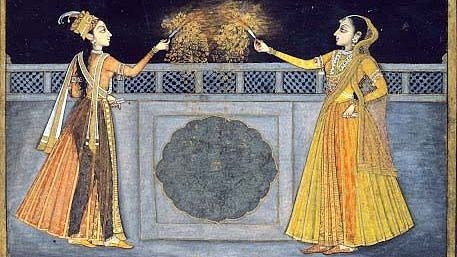Diwali
Diwali was known as the Jashn-e Chiragha’n under the Mughals and was celebrated with great enthusiasm. The Rang Mahal in Red Fort was lit up with diyas on Diwali as can be seen in a painting of Emperor Mohammad Shah Rangeela celebrating Diwali outside the palace with some ladies. The emperor was a poet and Rangeela was his nom de plume.
The Mughal emperor was weighed in gold and silver, which were distributed amongst the poor. It is said that some Mughal ladies would climb to the top of the Qutub Minar to watch the lights and fireworks. Fireworks under the supervision of the mir atish would be ignited near the walls of the Red Fort. And a special Akash Diya (Light of the Sky) was lit with great pomp, placed atop a pole 40 yards high, supported by sixteen ropes, and fed on several maunds of binaula (cottonseed oil) to light up the darbar.
Dussehra
The enthusiastic participation of the Muslims in the Hindu religious festivities celebrated under the patronage of the Mughal kings reflected the prevalence of a composite culture in medieval India, where social and cultural interaction between the two communities flourished at various levels, enriching both.
Maheshwar Dayal’s book, Aalam Mein Intekhaab: Dilli, published in 1987 by Urdu Academy, describes the history, traditions and culture of Delhi from Mughal times to date. One of the things that fascinated me was the book’s description of the celebration of festivals in the walled city, particularly Dussehra and Ramlila.
After Emperor Shah Jahan shifted the Mughal capital from Agra to Delhi and established the walled city of Shahjahanabad, he extended his patronage to celebrations of various important Hindu festivals observed by his army and people. Dussehra was one such festival, which was established for the Hindu soldiers of his army, on the banks of the River Yamuna, behind the Red Fort.
The Mughal emperors consolidated their rule in India with inter- religious marriages, intermingling with the local rulers and populace and adopting local customs, often mixing time with theirs, which had come from Central Asia and Persia.
Also read: Diwali sweets and snacks are on their way. Here’s how you can ‘health-ify’ them
Ramlila, an important part of the Dussehra celebrations, is a theatrical enactment of the Ramayana, narrating the story of the triumph of good over evil. The first Ramlila Committee in Delhi was established by Emperor Bahadur Shah Zafar, and it continues to exist till date.
Mirza Qateel in his Persian book, Haft Tamasha, written in the eighteenth century, says that the Hindus and Muslims celebrated Dussehra and Ramlila together with great gusto. In the markets and chowks of Delhi, huge effigies of the demon-king Ravana made of cardboard and paper were erected. In Ravana’s stomach, an earthen vessel containing sherbet was placed, and small children dressed up as Lord Rama came and fired arrows at this vessel. Huge crowds would gather to watch this spectacle.
Another tradition in those days was the distribution of sherbet in earthen cups called kulhads to everyone. People drank the beverage as a symbol of victory over Ravana ‒ the red-coloured sherbet signifying Ravana’s blood. A very big fair was held on the banks of the Yamuna, which drew crowds from far and wide. According to Dayal, on the morning of Dussehra, the Mughal emperor would hold a darbar, or the royal court, at the Red Fort. In accordance with tradition, the bird Neelkanth (Indian roller), which signified victory and success as per Hindu traditions, would be set free in front of the emperor. In fact, it is called the Dussehra bird in folklore. In addition to this practice, a falcon was brought to perch on the emperor’s hand. According to Timurid traditions, the falcon symbolized victory and success. This is a classic case of adopting and adapting to local customs.
The emperor on Dussehra rewarded the courtiers and citizens in his darbar. In the evening, the darogha (in-charge) of the royal stables had the horses decorated with henna on their hooves and designs on their forehead, and they were bedecked with jewellery. They would then be taken to the Red Fort and paraded under the jharoka (window). The emperor would inspect them and reward the grooms for the best-decorated horses. Beautifully adorned horses and elephants would also be taken to the havelis (mansions) of the nobles and rewarded suitably.
During the nine days preceding Dussehra, called ‘Navratri’ or nine nights, barley would be sown in small boats. On the day of Dussehra, old and young alike would decorate their caps, turbans and ears with barley sprigs, as it was considered auspicious.
Also read: Why India’s prime ministers give their Independence day speech from Delhi’s Red Fort
Since Persian was the court language and widely understood, the quatrains of Tulsi Das’s Ramayana would be recited in Persian for all to enjoy and understand. Verses would be composed in Urdu and Persian for the occasion.
Ramlila would be enacted everywhere, and people dressed as Lord Rama, Sita, Lakshman and Ravana were taken around on chariots. Every day there would be new tableaus in the procession. When Lord Rama’s exile was enacted, a boat with a boatman would ferry Lord Rama, Sita and Lakshman across Shahji’s pond (a symbolic Ganga) near the Ramlila grounds. After 1947, the pond was filled up to make way for Kamla Market. During the day, children would dress up as Rama and Sita and enact the Ramayana. In the evenings, enormous crowds of Hindus and Muslims, men and women, young and old, rich and poor would gather at the Ramlila grounds to watch the plays there.
